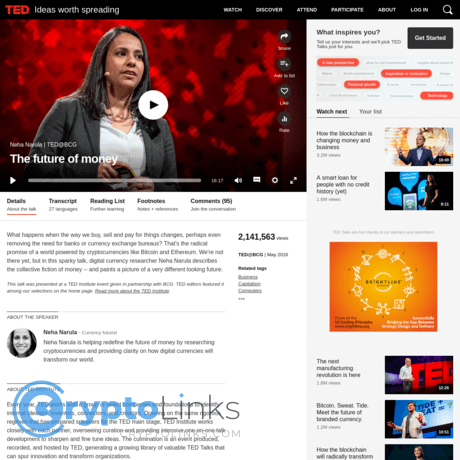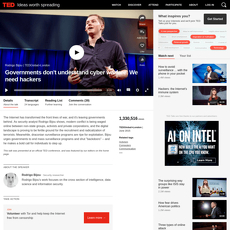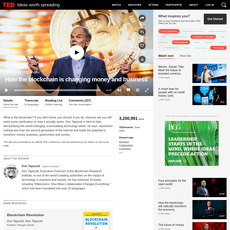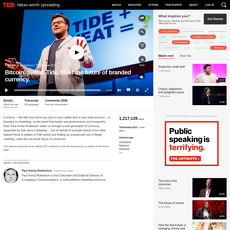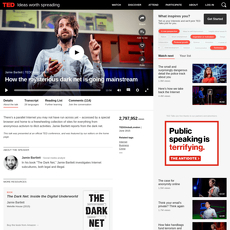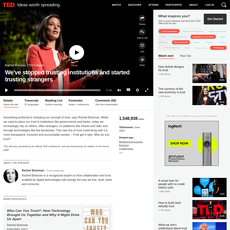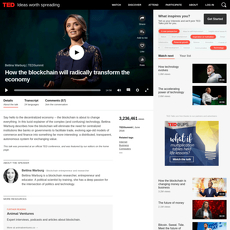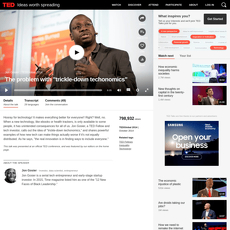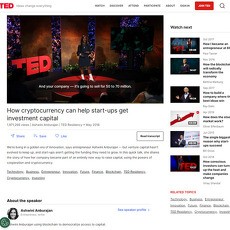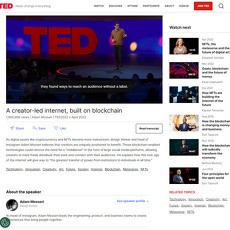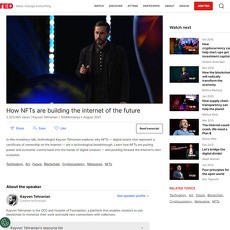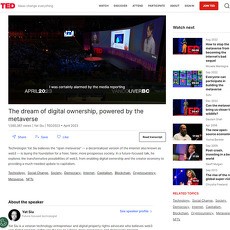Neha Narula: The future of money Review
Neha Narula: The future of money
www.ted.com
Neha Narula: The Future of Money — TED Talk Review Guide (Everything You Need to Know + FAQ)
What happens when money becomes software you can send like a text? If that question excites you but the usual crypto chatter leaves you more confused than inspired, you’re in the right spot.
I watch talks like Neha Narula’s with a reviewer’s eye: what’s signal vs noise, what’s useful for real people, and what builders and investors should do next. If you’ve ever felt lost between CBDCs, stablecoins, and blockchain buzzwords, this guide will help you watch smarter and walk away with real takeaways.
The problem most people have with “the future of money”
Let’s be honest—most content on this topic either goes too technical or stays vague and motivational. Meanwhile, the world is changing fast:
- International transfers still often take days and cost real money (banks can charge $15–$50 per wire, and remittance fees are frequently 5–7%—see the World Bank’s Remittance Prices).
- Merchants eat 2–3% card fees on many payments, which kills margins for small businesses.
- About 1.4 billion adults remain unbanked globally (Global Findex), even as CBDC pilots and stablecoins race ahead (CBDC Tracker).
You don’t need more jargon. You want clarity: what matters now, what to watch next, and how this affects your wallet, business, or portfolio.
What I promise you’ll get here
I break down Neha Narula’s TED talk in plain English, highlight the key ideas, and make it practical:
- Clear framing of “money as software,” without hype.
- What’s realistic vs speculative—right now.
- How this maps to crypto, stablecoins, and CBDCs you’re actually hearing about.
- Simple actions to take whether you’re a user, builder, or investor.
You’ll also get context for sharing with your team—concise talking points you can use in product meetings, strategy docs, or onboarding sessions.
Who this guide is for
- Crypto-curious newcomers who want a smart intro to digital money without getting lost.
- Builders, analysts, and investors who need a credible framing to align teams fast.
- Everyday readers who want a no-nonsense review from someone who covers crypto tools daily on Cryptolinks News.
What you’ll learn
- Why the phrase “money is becoming software” actually matters.
- How the talk connects to today’s realities: stablecoins, CBDCs, and open crypto networks.
- What this means for UX, security, regulation, and everyday payments—from your wallet to your business checkout.
How I reviewed this talk
I watched with a few filters in mind:
- Clarity of vision: Does it cut through buzzwords to explain what changes for real people?
- Technical grounding: Are the claims consistent with how distributed systems actually work?
- Market alignment: Does it match what I’m seeing across wallets, exchanges, stablecoin rails, and CBDC pilots?
- Usability: Would non-experts understand how to act on this?
“Money is becoming programmable.” That’s the talk’s central idea—and the lens I use to separate signal from noise.
TL;DR you can screenshot
- Money is turning into software. Think programmable value that moves at internet speed.
- Trust is the real battleground. The winners will balance openness, security, and privacy.
- We’ll live with multiple monies. Fiat, stablecoins, CBDCs, and crypto-native assets will need to interoperate.
- What matters right now: wallets that are safer and simpler, cheaper cross-border payments, and standards that keep networks open.
Why this talk is worth your time
Neha’s framing connects the dots between what’s possible and what’s responsible. For example:
- Programmable payments: Conditional payouts and automated escrow that settle instantly—no middleman.
- Lower-cost rails: Remittances that don’t burn 5–7% of someone’s paycheck just to land at home.
- Real access: Digital wallets that work on cheap phones and weak connections, instead of locking people out.
It’s not about picking one chain or cheering a ticker. It’s about building money that works like the internet—open, secure, and fast—without turning your life into a surveillance feed or your business into a fee machine.
If you’ve ever tried sending a wire on a Friday and watched it vanish into a long weekend, you’ll appreciate the vision here. If you’ve ever paid 3% in card fees on a thin-margin sale, you’ll see why programmable money and open standards could be a game-changer.
Curious who’s making this case—and why their voice carries real weight beyond typical crypto commentary? That’s exactly what I’m looking at next. Ready to meet the person behind the talk and see why you should listen?
Who is Neha Narula and why her voice matters
When I look for signal in a space full of noise, I pay attention to the people who build, ship, and stress-test the rails we all end up using. Neha Narula is one of those people. She isn’t just talking about digital money—she’s helping design how it should work when billions rely on it.
"Money is an agreement we make with each other." — Neha Narula, TED
Credentials and current roles
Neha’s resume isn’t just impressive—it’s unusually relevant to where money is headed:
- Director, Digital Currency Initiative (DCI), MIT Media Lab — DCI backs core research and open-source work that keeps digital money secure and usable. From funding Bitcoin Core contributors to publishing new payment architectures, this is where a lot of serious, non-hype progress happens. Explore the program: dci.mit.edu.
- Board of Directors, Block (formerly Square) — Block touches millions of merchants and consumers through products like Cash App and Square. Having a researcher with deep security and policy chops on the board signals where mainstream fintech is aiming. See Block’s board: block.xyz.
- Innovation Advisory Council, Federal Reserve Bank of New York — This group helps the NY Fed think through technology trends and their policy risks. That seat bridges academic rigor with real-world constraints. About the council: newyorkfed.org.
That mix—open-source, big fintech, central banking—means she sees the whole chessboard: incentives, failure modes, and where standards will be set.
Research focus
Neha’s work sits at the intersection that actually matters for “money-as-software” to work:
- Secure, scalable payment systems — She co-led the technical work behind Project Hamilton, a high-performance CBDC prototype with the Boston Fed, releasing the OpenCBDC codebase so anyone can review and test it. Benchmarks hit up to ~1.7M transactions per second in a lab environment—less about bragging, more about proving what’s technically possible under strict constraints. Code: OpenCBDC-Tx on GitHub.
- Privacy with auditability — Her team published zkLedger, a zero-knowledge approach that lets auditors verify ledgers without exposing everyone’s transactions—exactly the kind of balance businesses and regulators have been asking for. Overview: dci.mit.edu/zkledger.
- Open-source safety and Bitcoin robustness — DCI has supported Bitcoin Core maintainers and critical security research, the invisible work that reduces catastrophic bugs and keeps the network trustworthy. Program page: dci.mit.edu/bitcoin.
These aren’t slides or slogans—they’re shipped prototypes, peer-reviewed ideas, and sustained support for the code a lot of us rely on without ever noticing.
Why her perspective stands out
Most commentary either waves a flag for a single coin or gets lost in marketing buzz. Neha cuts a different path:
- Innovation with guardrails — She’s enthusiastic about programmability, but insists on threat models, audits, and real UX. Money cannot be “move fast and break things.”
- Public-interest tech — Her work asks, “Who gets excluded? What are the privacy defaults? How do we avoid lock-in?” That lens matters when the next billion users are coming from places where a payment error isn’t an inconvenience—it’s rent, food, and safety.
- No maximalism — She’s not trying to crown a single winner. Instead, she looks for systems that scale, interoperate, and balance trade-offs across open networks, stablecoins, banks, and potential CBDCs.
If you’ve ever felt torn between ideals (openness, censorship-resistance) and the messy realities (compliance, fraud, uptime), her work lives exactly in that tension—and tries to resolve it with design, not slogans.
What this means for you
Here’s why her voice is worth your attention if you care about where payments and savings are heading:
- Better rails are coming — Faster settlement and cheaper cross-border movement aren’t science fiction. The OpenCBDC work shows what’s feasible at national scale; Bitcoin funding and research push reliability at global scale. Both pressures improve the wallets and apps you’ll actually use.
- Privacy won’t be an afterthought — Solutions like zkLedger show a path where businesses can get compliance and audits without turning every user into a glass house. Expect more products to adopt “privacy-by-default, audit-when-needed.”
- Interoperability will decide winners — If you run a business or build products, plan for a world with multiple monies and networks. Open standards and bridges are not “nice-to-have”—they’re survival. Neha consistently pushes for this framing.
- Less hype, more signals — Her vantage point filters out the flashy features that crumble under real usage. If something survives her threat model, it’s worth your time.
I’ve seen too many people burn time (and money) chasing shiny updates while missing the quiet, structural shifts. Neha’s body of work points to those shifts with receipts and code you can read.
So how does she translate all of this into the talk itself—what specific ideas should you listen for, and where are the “aha” moments that change how you think about money-as-software? Let’s break it down in plain English, with the exact parts you’ll want to replay.
The talk, in plain English: key ideas and moments
Money as software
Here’s the heartbeat of the talk: when money becomes code, it moves at internet speed and follows rules you can program. Not just “send and receive,” but if-this-then-that logic you already expect from modern apps.
- Conditional payments: Think rent deposits that auto-release when a smart lock confirms checkout. No phone calls, no disputes—just code executing the agreement. Tools like oracles (e.g., Chainlink) already let contracts react to real-world events.
- Streaming money: Salaries paid by the second instead of every two weeks. Projects like Superfluid have shown how streaming USDC can match the way people actually live and work.
- Automated safeguards: If a wallet is compromised, funds can route to a “safe address” unless a hardware key confirms large transfers. That’s programmable risk control, not guesswork.
- Compliance in code: Stablecoins like USDC can enforce sanctions lists on-chain. That’s powerful—and it raises important questions about who controls the switch.
Once you see money as software, you stop asking “which coin?” and start asking “what rules should value follow?” That’s where this talk shines.
“Money is an agreement we encode—and can re-encode—through software.”
Trust is the real battleground
Speed gets headlines, but trust decides everything. Who do we trust with the rules of our money: banks, governments, platforms, or open networks? The honest answer is probably a blend—and that’s exactly the tension she surfaces.
- Centralized risk is real: We’ve seen the cost of trusting single points of failure—exchange blow-ups, platform freezes, black-box risk models.
- Decentralized risk is different: Smart contract bugs, governance capture, and key management mistakes can be just as brutal. The DAO hack isn’t a history lesson—it’s a design warning.
- Secure-by-design or it doesn’t scale: If code runs money, audits, formal verification, and hardware security aren’t “nice to have.” They’re the difference between progress and a bad headline.
That’s why I like the tone here: optimistic about open systems, but grounded in how fragile trust can be when things go mainstream.
Speed, access, and costs
The talk hits a nerve many of us know firsthand: today’s rails are slow, expensive, and exclusionary.
- Cross-border pain: The World Bank has tracked average remittance fees around ~6% to send $200. That’s not a bug—it’s how the system works today for millions of families.
- Unbanked and underbanked: Global Findex (2021) estimated roughly 1.4 billion adults without a bank account. If money is software, access is just an app download—if we build it right.
- Real-time expectations: ACH can take days; card settlements take even longer behind the scenes. Meanwhile, stablecoins settle in seconds with near-zero network fees on certain chains, and the Lightning Network makes small-value payments feel instant.
The takeaway isn’t “crypto fixes this” by default. It’s that digital currency networks can cut costs and widen access—if privacy, security, and UX aren’t afterthoughts.
Interoperability and standards
We’re headed for a world with many monies: bank deposits, stablecoins, CBDCs, and crypto-native assets. If they can’t talk to each other, users will get stuck in walled gardens again—and we’ll repeat the same mistakes with shinier logos.
- Open standards or bust: Think ERC-20 for tokens, ISO 20022 for messaging, and identity standards (W3C) that let wallets prove “just enough” about you without oversharing.
- Bridges are both promise and risk: Cross-chain bridges have been a target; Chainalysis reported multi-billion dollar losses to bridge exploits in 2022. Interop must be built like critical infrastructure, not weekend hacks.
- Public interest tech: If CBDCs and stablecoins don’t adopt open, auditable standards, we’ll get faster payments but tighter lock-in. That’s not the future anyone asked for.
Interoperability isn’t a feature—it's the market. Without it, everything fractures.
Timestamps and quotes to note
- “Programmable money” moment: When she explains that code can move value like a message, pause and imagine your own workflows as rules—not emails, forms, or approvals. That mental shift is the point.
- Security trade-offs: Listen for the parts about trust and governance. If the rules live in software, who updates them—and how do we prevent quiet, unilateral changes?
- Public interest lens: She calls out the importance of building money for everyone, not just power users. That’s your clue to watch for design choices that protect privacy by default.
If money is turning into software, what should you upgrade first—your wallet habits, your product roadmap, or your settlement rails? Keep going; the next section breaks this into concrete moves you can make this week.
What this means for crypto users today
“Money is an agreement we all accept — and we can upgrade that agreement with software.” (TED)
You don’t need to be a protocol engineer to feel this shift. If you send money home, the fee stings. If you’re building, a bug keeps you up at night. If you sell online, payout delays kill momentum. Here’s how to turn the talk’s big ideas into moves you can make right now.
For holders and everyday users
Wallets and payment rails are getting easier, faster, and cheaper. But “easy” shouldn’t mean “careless.”
- Use seedless or safer recovery, not screenshots. Smart-account wallets (ERC‑4337) like Coinbase Smart Wallet and multisig options like Safe let you use passkeys and social/guardians instead of a single seed phrase. That’s less panic and fewer sticky notes.
- Cut cross‑border fees with stablecoin rails. USDC on fast chains often settles in seconds for cents. See Stripe’s USDC support and USDC details. Compare that to the World Bank’s average remittance cost near 6%+ in many corridors.
- Watch fee trends, not just prices. Ethereum’s EIP‑4844 lowered L2 fees dramatically. Track costs and security assumptions across L2s on L2BEAT before choosing where to park funds.
- Know your privacy settings. Your wallet can leak more than you think. Try fresh addresses, avoid unnecessary address reuse, and understand that many fiat-backed stablecoins include freeze functions. If privacy is a must, look into assets designed for it and learn the rules in your region first.
- Lightning is useful when it fits your life. For small Bitcoin payments, the Lightning Network can be instant and cheap. Just confirm your app’s channel liquidity and routing before you rely on it.
Quick reality check: crypto theft still happens. Chainalysis and Immunefi both report billions lost to exploits and scams across recent years (Chainalysis, Immunefi). Treat wallet hygiene like locking your front door.
For developers and startups
Users won’t tolerate trade‑offs that feel like homework. Build for speed, safety, and reality.
- Interoperability without UX pain. Abstract chains with account abstraction and intent-based flows; let users pay fees in what they hold when possible. Don’t force them to collect gas tokens like Pokémon.
- Compliance that respects privacy. Implement the FATF Travel Rule and MiCA-aligned flows with data minimization. Use verifiable credentials and selective disclosure where possible (W3C VCs) so you verify what’s needed without hoarding user data.
- Security is a product feature. Budget for multiple audits and continuous testing:
- Static analysis and fuzzing: Slither, Echidna, Foundry invariant tests.
- Public review: Code4rena competitions, Immunefi bounties.
- Threat modeling: STRIDE sessions each release; practice incident response with real runbooks.
- Bridges are sharp objects. If you must go cross‑chain, pick proven messaging layers, design for pause/kill‑switches, and set caps/ratelimits. Communicate the risk profile clearly to users.
- Instrument, don’t surveil. Collect only what helps reliability and fraud prevention. Be transparent. Delete what you don’t need. Being worthy of trust is a growth strategy.
For businesses and creators
Faster settlement isn’t a flex—it’s cash flow. And global reach shouldn’t mean giving half of it to middlemen.
- Stablecoin payouts for contractors and fans. Pay or accept USDC and convert locally via regulated ramps. Many creators see near‑instant settlement with sub‑1% costs versus days and 3–7% on legacy rails.
- Offer multiple payment rails. Keep cards and bank transfers, but add on‑chain options. Stripe’s on‑chain USDC support and similar services can route funds where you need them without rebuilding your checkout.
- Plan chargeback‑resistant revenue. On‑chain sales and subscriptions through smart accounts reduce disputes and lower overhead. Make refunds a button, not a support saga.
- Manage treasury risk. If you hold stablecoins, document issuer risk, freeze controls, and chain risk. Spread balances across issuers/chains if material. Reconcile with monthly attestations.
For policy watchers
We’re not moving to one new system; we’re stitching several together. The design choices now will stick for decades.
- Expect blended rails. Bank money, stablecoins, and CBDCs will coexist. Cross‑border pilots like BIS mBridge and Project Cedar show where this is headed (BIS mBridge, NY Fed Cedar).
- Anchor privacy as a requirement, not a nice‑to‑have. Offline and small‑value transactions should have strong privacy. The digital euro discussions around offline mode and caps are a useful reference point.
- Open standards win. Push for interoperability across public and private rails (messaging, identity, settlement) so we don’t end up with national or corporate silos that tax innovation.
- Programmability with guardrails. Limit freeze/blacklist powers, require public documentation of controls, and offer redress mechanisms users can actually navigate.
Quick checklist
- Wallet basics: turn on passkeys/biometrics, set up recovery (guardians or hardware), and test it once.
- Fees: compare an L2 or fast chain stablecoin transfer vs your current method. If it’s 10x cheaper and faster, switch for routine payments.
- Security habits: verify URLs, use allow‑listed addresses for big transfers, and keep a “cold” wallet for savings.
- Builders: line‑item audits and bounties in your budget; run threat modeling before each feature sprint.
- Data: collect less, delete more. Publish a short, human policy on what you track and why.
Curious how this practical lens lines up with Bitcoin hard‑money thinkers, Ethereum’s builder culture, and central bank plans? I’m about to stack Neha’s view next to theirs—who agrees, who pushes back, and where the real tension sits. Ready for that comparison?
How Neha’s view compares with other leaders
Bitcoin and the hard‑money crowd
Bitcoin folks fight for neutrality, scarcity, and censorship‑resistance. On that, there’s overlap with Neha’s stance on openness. Where she turns the dial is on usability and public-good infrastructure—the unglamorous rails that help billions actually use this stuff without shooting themselves in the foot.
Real-world tension points I see:
- Security vs. UX: Self-custody is pure, but it’s fragile for mainstream users. Neha pushes for designs that minimize catastrophic mistakes—think social recovery and better defaults—without handing power back to middlemen.
- Payments beyond memes: The Lightning Network is a serious attempt at scaling everyday bitcoin payments. It powers Strike and is wired into Cash App. But liquidity management and routing reliability still bite operators; Neha’s lens says, “great direction—now prove it works at national scale with predictable UX.”
- Public capacity ≠ mass adoption: Lightning’s public capacity counts in the thousands of BTC, which is impressive—but logistics (channel health, mobile key security) still gate the leap from early adopters to everyone else.
“Trust isn’t a feature; it’s the product.” If people can’t reliably pay, save, and recover, ideology won’t save the day.
It’s less ideology, more systems thinking. Hard money is the foundation; the house needs plumbing, locks, and smoke detectors.
Ethereum and programmable finance
Ethereum shares Neha’s excitement for money-as-software: composability, smart contracts, and open experimentation. Where her perspective hits harder is on guardrails: security, privacy, and scale that don’t crumble under real demand.
Patterns I watch through her filter:
- Programmability with insurance‑grade safety: DeFi is a laboratory, but labs explode. According to Chainalysis, crypto hacks have cost users billions across recent years. Neha’s take: audits, formal verification, and kill-switch policies can’t be an afterthought. If it moves money, it needs a threat model and a budget.
- Scaling trade‑offs: L2s (Optimism, Arbitrum, Base, zk-rollups) are reducing costs, but they add bridges, operators, sequencers, and new attack surfaces. Her compass says: push scale, but keep exits open and failure modes contained.
- Privacy that plays nice with compliance: Post-Merge realities showed how relays and MEV policies can drift toward censorship. Neha’s framing favors privacy-preserving techniques that still enable verifiable compliance—less “black box,” more “provable controls.”
- Account abstraction is a big deal: Smarter wallets (EIP‑4337 and friends) can enable spending limits, session keys, and social recovery. That’s exactly the human-centric layer she keeps pointing at.
In short: she loves the superpowers, but insists they come with seatbelts that actually latch.
Central banks and CBDC advocates
On inclusion and speed, there’s strong alignment. Neha has been close to the work—MIT’s team co-led Project Hamilton with the Boston Fed, a high‑throughput CBDC prototype that showed seven‑figure transactions per second in lab conditions. That’s real engineering, not slides.
Where she pushes back is where most citizens get nervous too: surveillance and lock‑in.
- Open standards or it doesn’t count: If a CBDC is a walled garden, it risks choking the ecosystem. Her bias is toward open, interoperable designs that work with bank money, stablecoins, and crypto rails.
- Privacy by architecture, not by promise: The BIS has reported that the vast majority of central banks are exploring CBDCs. Great—now prove privacy properties with public specs and testable guarantees, not press releases.
- Programmability with constraints: Features like time-limited stimulus or restricted-use funds can help policy—but they also scare people. Her stance: design guardrails, publish them, and keep “narrow purpose” functions from becoming “anything goes.”
CBDCs can upgrade public money, but only if citizens feel like owners, not subjects.
Fintech rails (stablecoins, payment apps)
Fintechs are the bridge between today and tomorrow. Stablecoins like USDT and USDC already move vast sums daily; Visa now settles in USDC on Ethereum and Solana, PayPal runs PYUSD, and Stripe brought back crypto support with USDC payouts. That’s not theory—it’s live traffic.
Neha’s filter adds two reality checks:
- Interoperability or bust: If wallets, stablecoins, and off‑ramps become closed loops, we’ve rebuilt the old silos with shinier skins. Open APIs, portable identity, and standardized messaging (yes, even boring ISO 20022 bridges) keep users free to switch.
- Resilience beats vanity metrics: One issuer outage, one blacklisting mistake, one deplatforming wave—and trust evaporates. Transparency on reserves, clear redemption rights, and predictable on/off‑ramp policies matter more than market cap charts.
Fintechs nail onboarding and UX. Neha’s contribution is a reminder: don’t trade long‑term freedom for short‑term convenience. Nobody wants their paycheck frozen because an algorithm misread a transaction note.
Where all these camps meet: open standards, credible privacy, and safety that holds under stress. Programmable money only wins if the pipes are as trustworthy as the promises.
You’re about to watch the talk—want a simple way to catch the real signals and skip the fluff? In the next section, I’ll share the exact prompts I use before, during, and after a talk to turn insights into action. Which one do you want first: the 60‑second pre‑watch checklist or the timestamp traps to pause on?
Watch smarter: how to get the most from the TED talk
Before you watch
I like to make the talk do work for me. Before hitting play, I set a target: what problem do I want “money-as-software” to actually fix in my life or product?
Try this 5-minute warmup:
- Define your #1 friction. Examples:
- Sending money abroad costs too much. (World Bank data shows average global remittance costs still hover around ~6%—painful on small transfers.)
- My payouts land too slow. (Many bank transfers still take 1–3 business days in the U.S.; instant options like FedNow exist but coverage is limited.)
- I can’t reconcile payments easily across platforms. (Multiple providers, no shared standard; high ops overhead.)
- I’m worried about privacy when everything becomes traceable.
- Write a one-line goal. “If I learn one thing from this talk, it’s how to cut my [fees/time/risk] by [X%/hours/incidents].”
- Pick your lens.
- Everyday user: safer wallet, cheaper cross-border, fewer surprises on fees.
- Builder: clear trade-offs for security, privacy, and interoperability.
- Business: faster settlement without locking into closed silos.
- Policy watcher: where open standards can protect users at scale.
Bring one real scenario. Two quick samples I use:
- Freelancer in the Philippines paid by a U.S. client: Compare ACH-to-remittance versus stablecoin-to-local off-ramp. Track total cost, arrival time, and steps. (McKinsey’s Global Payments reports show cross-border B2B can run 2–10% in costs; that’s your benchmark to beat.)
- Ecommerce shop with EU and LATAM customers: Map chargeback risk, FX fees, and refunds across cards, PayPal, and a stablecoin rail. Decide where programmability could automate refunds or prevent fraud.
Prep note: “Money-as-software should help me [action], without sacrificing [privacy/security/portability].”
While you watch
I take notes with two columns: Promise vs Trade-off. Every neat claim gets a trade-off beside it. That’s where the real learning happens.
- Listen for trust and standards. Who carries trust in each example—banks, platforms, open networks? Is there a pathway for different monies (fiat, stablecoins, CBDCs, crypto assets) to interoperate?
- Mark the core tensions:
- Speed vs. finality: Instant is great—can disputes be resolved later? What’s the rollback story?
- Privacy vs. compliance: What designs minimize data while meeting rules? (Think “least data necessary” and selective disclosure.)
- Openness vs. safety: Open rails attract builders—but how do we prevent the same old walled gardens with new branding?
- Make a “spotting list.” I tick these when I hear them:
- Programmable conditions (escrow, streaming payments, automated tax or compliance hooks)
- Interoperability via open standards (not one vendor’s private API)
- Explicit security budgets (audits, threat modeling, key management)
- Privacy protections beyond “we comply” (design choices, not just policies)
- Translate to your world live.
- User: If this rail existed in my wallet today, what would I do differently this month?
- Builder: Where would I add a guardrail without breaking UX?
- Business: What single fee line could drop 50% with a smarter rail?
- Policy: What data is truly necessary for safety—and what can be kept private by design?
Note prompt: “This part matters to me because it replaces [manual step/vendor lock-in/fee] with [automated rule/open interface/lower cost].”
After you watch
Turn ideas into one controlled experiment. Keep it small, measurable, and reversible.
- Within 24 hours
- Improve wallet security: Enable hardware key or passkey, back up recovery phrase properly, and turn on address books to avoid mis-sends.
- Fee audit: List your last 10 payments. Note rail, fee, arrival time. Identify one switch you can test next week.
- Within 7 days
- Run a rail test (small value): Send the same $25 via your current method and an alternative rail (e.g., an instant domestic rail or a reputable stablecoin network). Record total fees, minutes to settle, and reconciliation steps.
- Interoperability check: If you build, sketch an interface boundary that lets you swap providers without rewriting your app (webhooks, event schemas, or standard message formats).
- Within 30 days
- Security budget, written down: Plan for at least one independent audit or threat model session. Treat it as a feature, not overhead.
- Data minimization pass: Remove any user data you don’t need. Add selective logging. If you store PII, encrypt at rest and restrict access by default.
Share one crisp takeaway with your team or friends and ask for a response in one sentence. Alignment beats a long memo. My template:
My takeaway: “The future of money is programmable, but trust and standards decide who wins. This week, we’ll test [rail] to cut [metric] by [target].”
Extras: transcripts and alternative formats
If you’re short on time, efficiency hacks help:
- Transcript skim: Read the transcript to mark the sections on programmability, trust, and standards, then rewatch only those minutes.
- Playback speed: 1.25x works well for dense sections; slow to 0.75x when she outlines trade-offs.
- Timestamp your notes: Add minute markers to each insight so you can rewatch and share the exact moment with your team.
- One-page brief: Turn your notes into:
- 3 bullets on what changes now
- 3 bullets on what to watch next
- 1 action you’ll take this week
Here’s the challenge I’ll leave you with: if the most powerful idea in the talk is that money is becoming programmable and networked, who do you want to trust with the defaults—and what standard will make that choice portable tomorrow? I’ll tackle the sharpest questions next and give you my no-BS verdict—curious which side I land on?
FAQ and final verdict
FAQs
Who is Neha Narula?
She leads the Digital Currency Initiative at MIT, sits on Block’s board, and advises the New York Fed’s Innovation Council. Her work is hands-on with cryptocurrencies and distributed systems. If you’ve heard about Project Hamilton (MIT + Boston Fed), that lab effort showed high‑throughput digital cash designs processing over a million transactions per second in testing—her world is where research meets real systems.
Is the talk pro‑crypto or anti‑crypto?
It’s pro‑innovation with guardrails. She backs open, secure, privacy‑respecting networks rather than any “one coin to rule them all” story. Think yes to programmable money and global access, no to weak security or surveillance‑by‑default.
Does this matter if I’m not into crypto?
Yes. You’ll feel the changes through payment apps, cross‑border transfers, and savings tools. For context, the World Bank keeps showing average remittance costs hovering around 6% for a $200 transfer—programmable digital money and stablecoin rails are already cutting that for many people. Visa and Stripe now experiment with stablecoin settlement, and companies pay global freelancers in USDC to skip slow wires. You don’t need to be “in crypto” to benefit from faster, cheaper rails.
Is this all hype?
No, but it’s not magic either. Real examples: Visa settling with USDC on certain networks; Stripe adding USDC payouts; stablecoins processing billions in daily volume; and faster payments like FedNow rolling out domestically in the U.S. On the flip side, CBDCs like Nigeria’s eNaira and the Bahamas’ Sand Dollar show that if UX and trust aren’t there, usage stalls. The direction is real—execution quality decides winners.
What should I do after watching?
Three quick moves:
- Upgrade your wallet setup: enable passkeys or hardware security, set social/key recovery, and label your “hot” vs “cold” funds.
- Compare rails for your use case: test an on‑ramp and a stablecoin transfer versus your bank wire; measure fees, speed, and support.
- Follow projects that care about interoperability and privacy. Bridges and cross‑chain standards are where lots of risk lives—Chainalysis reported bridges made up a huge share of funds stolen in 2022. Pick tools with audits and strong track records.
Is she bullish on CBDCs replacing everything?
No. Expect coexistence: bank money, stablecoins, CBDCs, and crypto‑native assets. The key is open standards so value moves safely between them. Locked silos are the fast path to high fees and low innovation.
Will cash disappear?
Unlikely anytime soon. Cash still covers edge cases—offline, private, and resilient. The real shift is that “digital cash” is learning cash’s best traits while adding programmability and speed.
“Money is becoming software.” The winners will earn trust, not demand it.
My verdict
Watch it. It’s the rare talk that keeps both feet on the ground while showing a path forward. If you build products, manage risk, or just want your money to move like your messages, this will sharpen your thinking. The balance of security, privacy, and usability is spot on. Pair it with live case studies—stablecoin settlements, real remittance flows, and ongoing CBDC pilots—to turn the ideas into action.
Who should watch vs skip
- Watch: product teams, devs, fintech operators, policy folks, and curious newcomers who want signal over noise.
- Skip (or skim): if you only want price targets or trading tips; this is about systems, not moon shots.
Conclusion and next steps
Money is becoming programmable and networked. The next chapter belongs to those who balance openness, security, and usability—and who can interconnect multiple forms of value without locking users in.
Start here: watch the TED talk at this link. As you watch, jot one action you’ll take this week—tighten your wallet security, test a new payment rail, or map your product’s interoperability plan.
Then check Cryptolinks News for practical picks, tool comparisons, and weekly updates on the rails that are actually shipping. I’ll keep tracking which networks are cutting costs, which wallets get security right, and which “standards” are real versus marketing. Smart money watches the plumbing.

